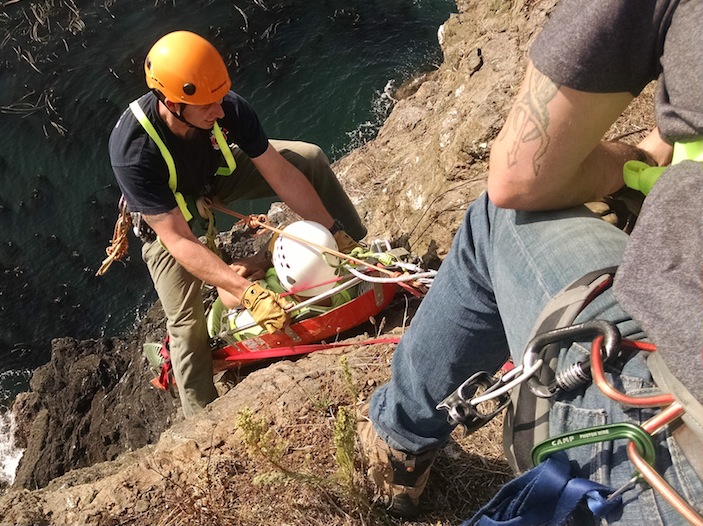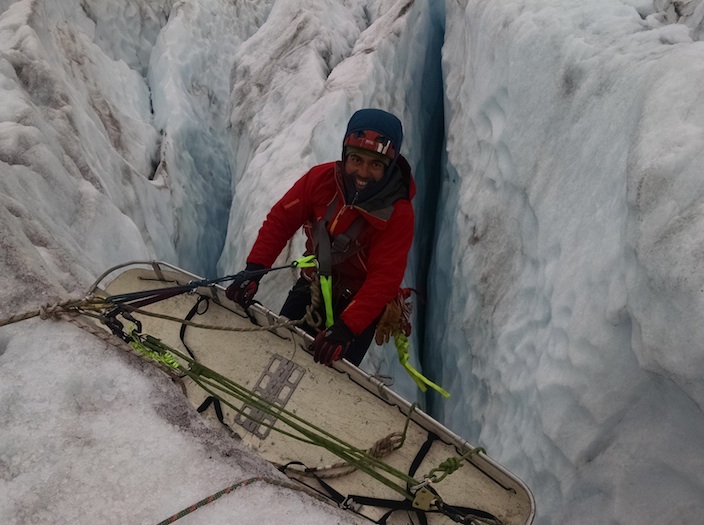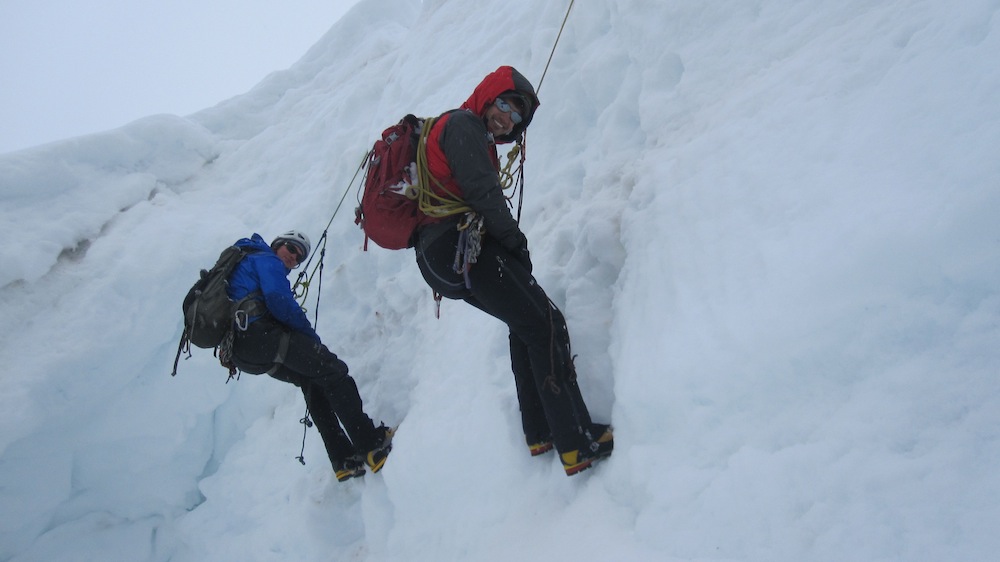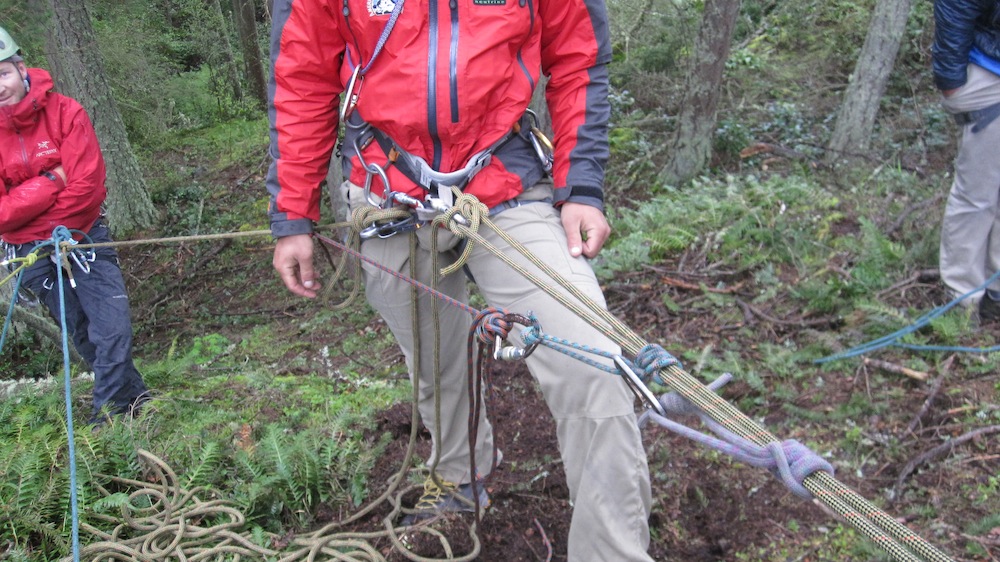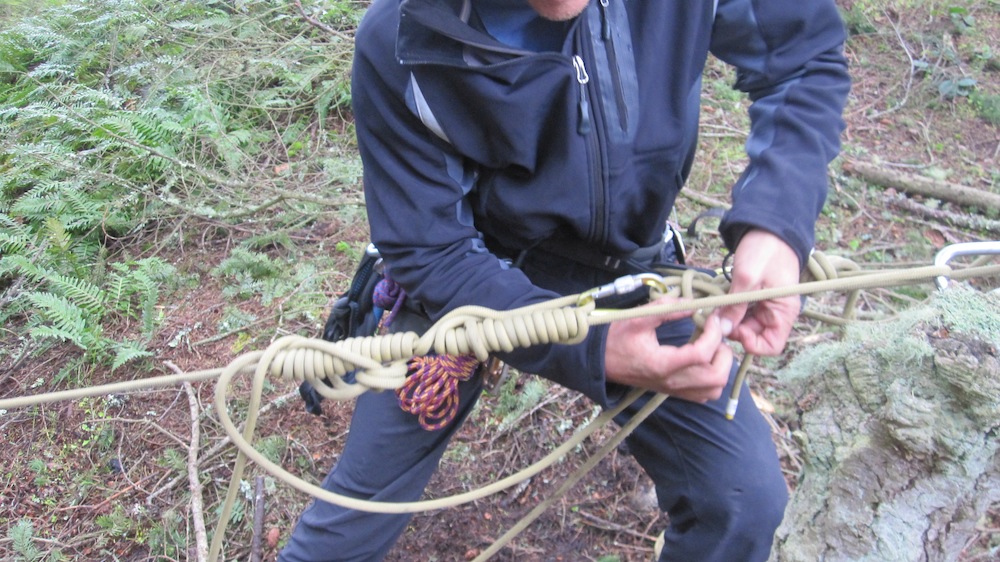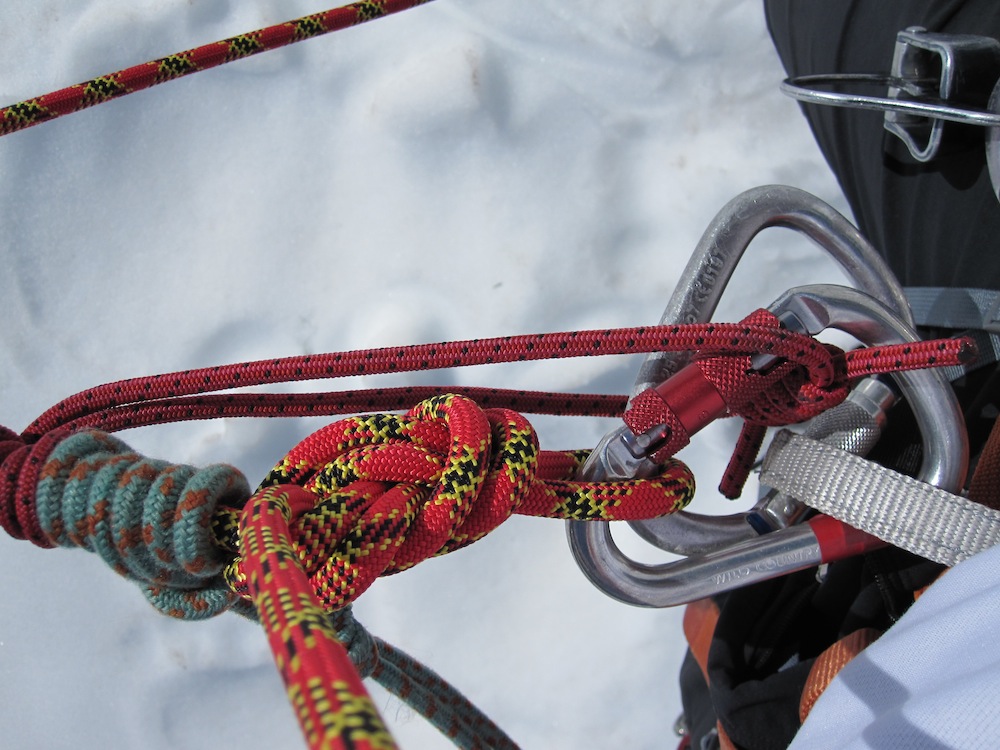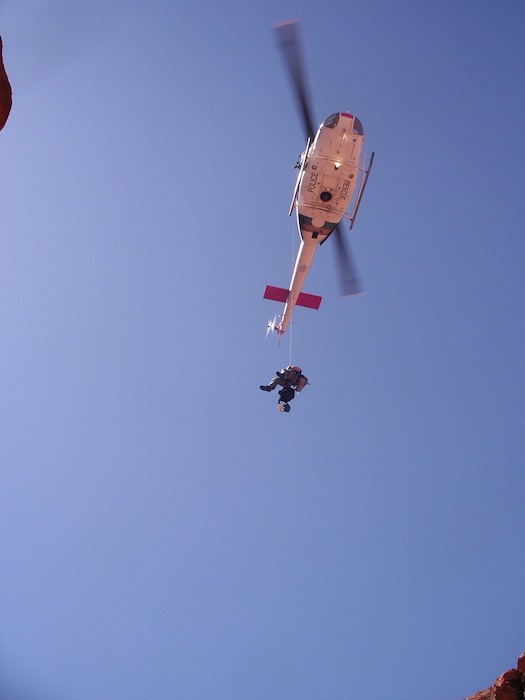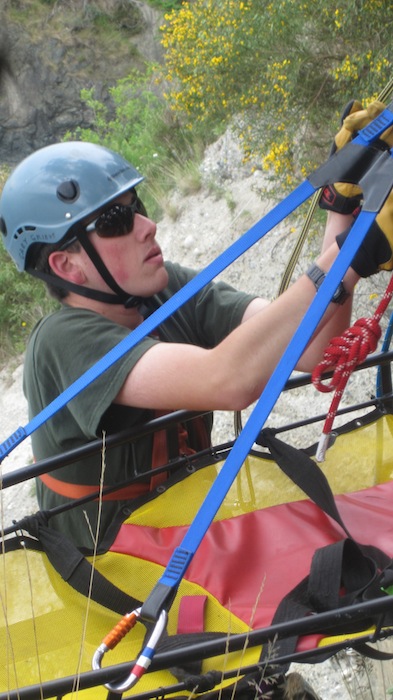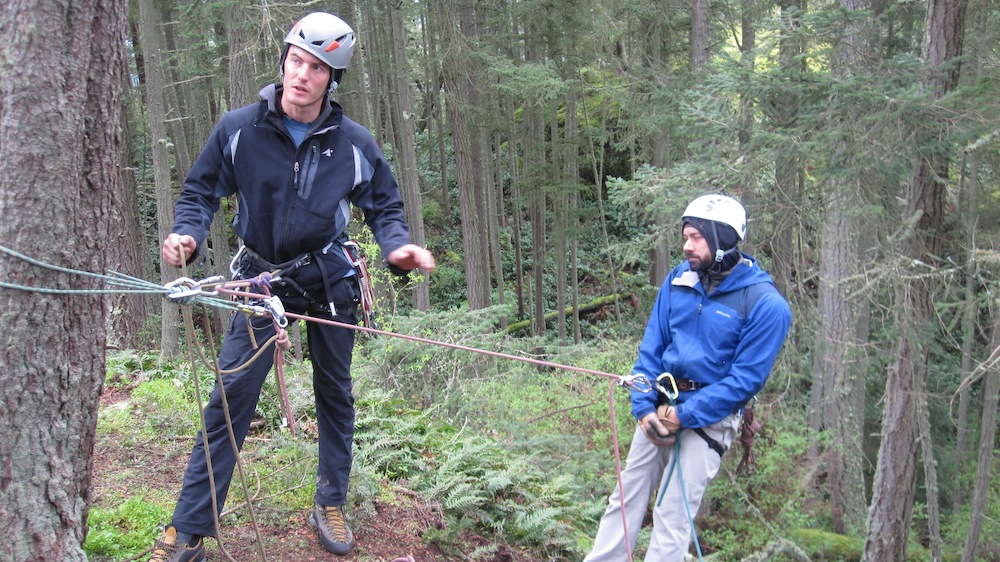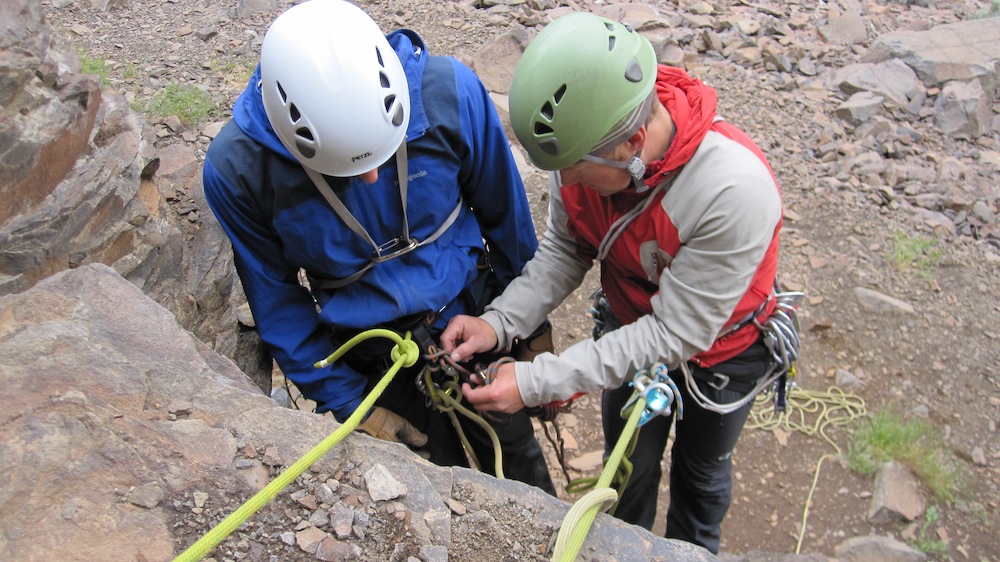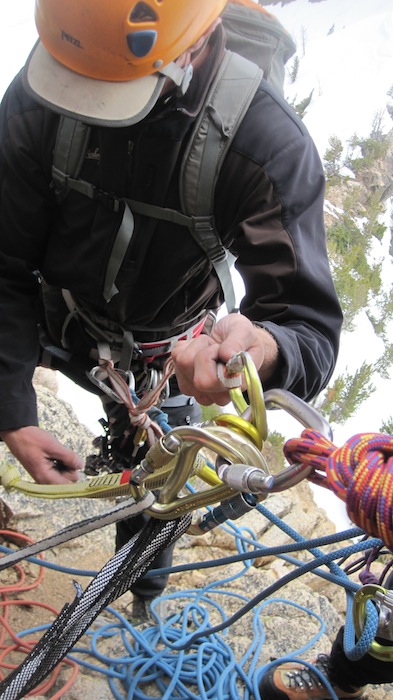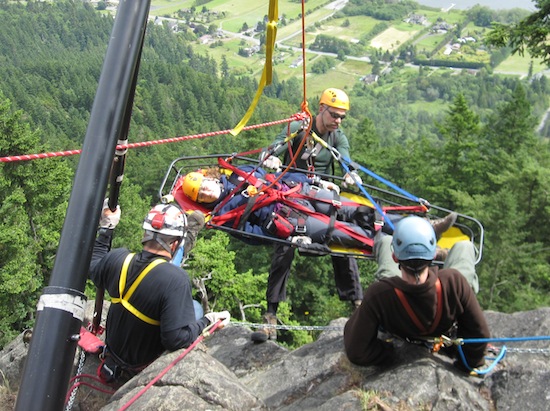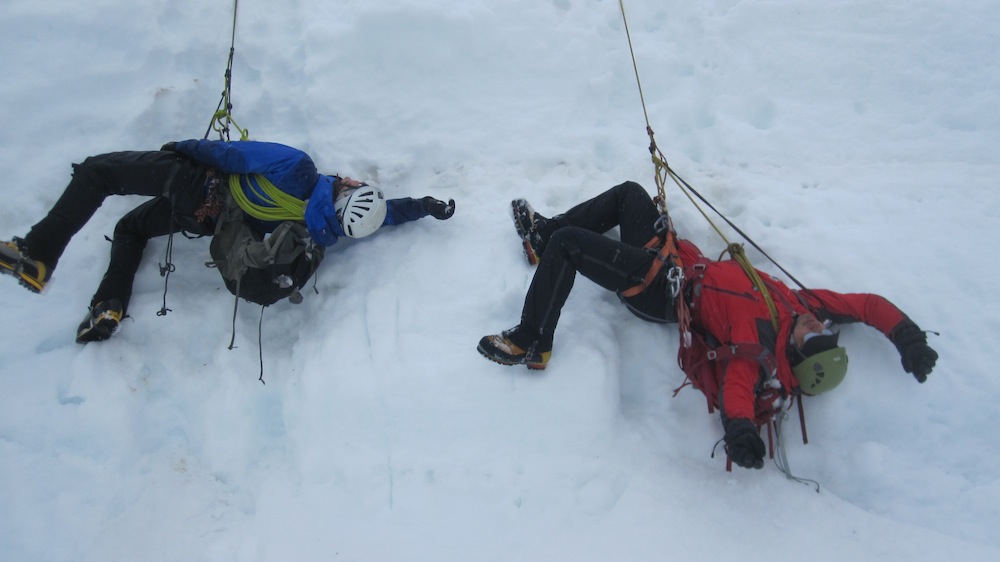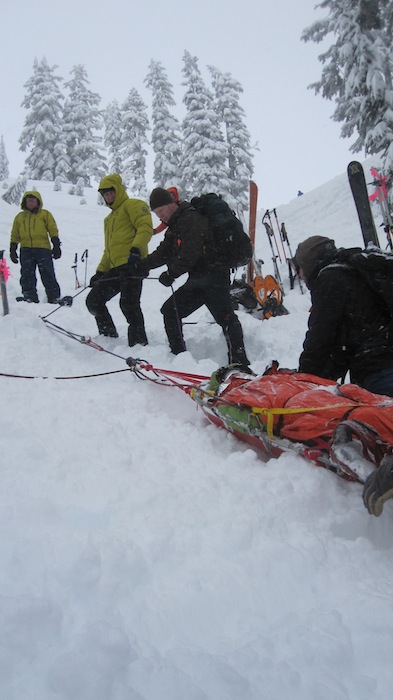Technical Rope Rescue Comprehensive Overview
A lead climber takes a fall, breaking his wrist and leg, four pitches off the ground. And the only person there to save him is his belayer…
A car goes off a steep mountain highway. The accident victim is injured and stuck on a precarious ledge, fifty-feet down. The local fire department is the only resource available…
An extreme skier slips in a "no-fall-zone" high on a mountainside, his body is lost in a crevasse at the base of a steep and exposed line. The local mountain rescue unit must mobilize to retrieve the skier's body.
A climber navigates a roaring river with a tyrollean traverse.
Each of these scenarios are radically different from one another. The resources available in each situation are different and the responses are different. However, there are many core rescue skills in each scenario that remain the same. Each of the situations requires a high level of proficiency in planning and incident response, risk management, and finally technical rope rescue work.
The first example in the scenario list is exactly what recreational rock and ice climbers may encounter, while the second and third examples are far more likely to be encountered by organized first responders. Unfortunately, most rescuers don't have the skills to deal with all three of these examples. Most either fall squarely in the "climber-self-rescuer" mold or in the "organized-team-rescue" mold. With this problem in mind the American Alpine Institute developed the most comprehensive technical rope and mountain rescue course offered in the country. It is perhaps the only rope rescue program to combine the concepts developed for team rescue with those designed for self-rescue. As a result, those who complete this course will have an extremely high level of skill in all forms of technical rope rescue and will be able to work dynamically in all forms of steep and high-angle rescue.
Rope rescue training programs with experienced instructors exist all over the United States and most of them provide a high level of training. The difference between the AAI model and the other programs available are twofold. First, the AAI Technical Rope Rescue Comprehensive has been designed for competent technical climbers and mountaineers. Instead of spending time on base-level climbing skills like simple belays and rappels, time is spent on "high-end" technical rescue scenarios. Second, while heavy front-country roadside and industrial rescues are addressed, the focus of the program is on light backcountry scenarios.
Rescue Organization Course Objectives
While some may take the rescue comprehensive to build their rope rescue skills, others must complete the course to meet the requirements of an agency. The Technical Rope Rescue Comprehensive meets or exceeds the criteria set forth by the following agencies and organizations:
Mountain Rescue Association Accreditation Requirements: The Technical Rope Rescue Comprehensive will provide students with the baseline skills required by the Mountain Rescue Association for accreditation in both low and high angle evacuation on rock, in snow and on ice. The MRA has three components for individuals:Search, Technical Rock Rescue and Snow and Ice Rescue. The Rescue Comprehensive does not include instruction in missing person searches or avalanche rescue, but does cover all other elements of the accreditation.
National Fire Protection Association: The Technical Rope Rescue Comprehensive provides skills compliant with NFPA Technician Level training. The course meets the standards identified by NFPA 1670, while also addressing the standards set forth in NFPA 1006 and 1983.
American Mountain Guides Association Rock Rescue Skills: The Technical Rope Rescue Comprehensive addresses the self-rescue and rock-rescue skills required by the AMGA for Instructor and Guide Certification. Those who take this course will have a strong understanding of the high-angle rescue scenarios evaluated by the AMGA and will be able to use their knowledge from the Comprehensive to train for Instructor and Guide Level AMGA Exams.
American Mountain Guides Association Crevasse Rescue Skills: The Technical Rope Rescue Comprehensive course will provide students with time to practice the specific crevasse rescue skills required by the AMGA for the Advanced Alpine Guides Course and the Alpine Guides Exam. Students will leave the course with a strong understanding of what the guide organization tests for and will have developed the skills to train for the exam.
International Technical Rescue Association: Three levels of practitioner are recognized by the ITRA. They are Level I Responder, Level II Technician, and Level III Advanced. Those who complete this program will have been instructed in Level III skills. To become certified at Level III, students will have to complete a separate skills assessment.
Technical Rope Rescue Comprehensive Certificate
Those who complete the technical rope rescue comprehensive will receive two certificates. The first certificate will be for the entire comprehensive, and the second will indicate that you have met the NFPA guidelines for a Rope Rescue Technician.
Technical Rope Rescue Comprehensive Curriculum Students will demonstrate proficiency in both self and team-rescue on multiple terrain types, including - but not limited to - steep and high-angle rock, snow and ice.
Curriculum Highlights
A patient is hauled on steep-angle terrain just outside Mount Baker Ski Area. Jason Martin
Team Rescue Hauling Systems - 3:1, 6:1 and 9:1
Self-Rescue Hauling Systems on Rock and on Snow and Ice - 3:1. 5:1, 6:1
Pulley Systems - simple, compound and complex
Lowering Systems - with a break rack, scarab, munter-hitch, super-munter, tube-style device, and autoblocking device
Anchor Systems - for team rescue and self-rescue on high-angle terrain, steep-angle terrain and on snow and ice.
Lowering Systems with a Litter
Use of a Guiding Line
Use of High Lines and Reeving Systems
Patent Packaging - with and without a harness
Specialized Rescue Equipment - including discussions of Class I-III harnesses, chest harnesses, rigging plates, pulleys, swivels, edge protection, and tripods
Improvised Rescue Equipment - waist and chest harnesses, improvised tri-pods and bipods, high points, and improvised anchors
Rope Climbing Techniques - with a friction-hitch system, with an autoblocking device, with an assisted breaking device
Belay Escapes - off an autoblocking device and off the body
Belays - tandem prusik belays, body belays, belay plates, mechanical belays
Passing Knots - in both a multi-pitch self-rescue setting as well as in a team rescue setting with a litter
Scene Management - command structure
Special Considerations for Mountain Rescue
Crevasse Rescue - critical procedures for team and self-rescue
Multi-Pitch Descents with a Patient in a Self-Rescue Setting
Helicopter Operations
Pick-Offs - patient pickoffs for rope rescue teams and self-rescue
Physics of Rescue Systems on Anchors and on Equipment
Rappelling - classic rappel, extended rappel, tandem rappel, and counterbalance rappel techniques
Knots - figure-eight family, overhand, double-overhand-on-a-bite, bowline, double bowline, long-tail bowline, butterfly, high tension tie-off, wrap-three-pull-two, and wrap-two-pull-one
Bends - double-fisherman's, overhand flat bend, water bend, double sheet bend, frost bend
Hitches - prusik, kliemheist, autoblock, clove, munter, and garda
Load Releasable Hitches - munter-mule and radium-release
Required Text
Technical Rescue Riggers Guide by Rick Lipke
This text may be purchased at the American Alpine Institute Shop or online .
Technical Rope Rescue Comprehensive Dates & Details
April 13 - April 27, 2024
Sept 28 - Oct 12, 2024
Nov 09 - Nov 23, 2024
Since this program is focused on the concept of team rescue , the training scenarios require a group of rescuers to perform all the necessary tasks. So with that in mind, a minimum of 5 students are required to be enrolled in order for this program to run.
Prerequisites
Climbers who are interested in taking the Technical Rope Rescue Comprehensive course should have experience with traditional climbing, anchors on snow and rock, mountaineering and crevasse rescue systems.
The parallel plaquette system is used as a light alternative in mountain rescue. Jason Martin
I appreciated the mix of classroom lecture with lots of hands on practice. I was forced to think on my own to build systems in the field, but had resources, teammates, and guides if I needed assistance. I liked the relatively fast pace of this course so we could fit a lot in. I only wish the course was longer because it was so awesome! - Becca F.
Inclusions and Exclusions
Included with the tuition are instructors, group equipment (both rescue and climbing), classroom location, permit fees, and transportation to and from field program locations.
Excluded are front-country lodging, personal climbing equipment, transportation to the classroom, food, trip insurance, camping equipment, and guide gratuities.
Private Programming
Any portion of this program, either the complete program or individual pieces of the program may be provided privately at any appropriate location. Please call the American Alpine Institute office for a quote.
Technical Rope Rescue Comprehensive Organizations & Credentials There are several organizations that oversee rescue standards in the United States. They all have different missions, but many of the core rope rescue components are the same.
Following is a list of the organizations that develop rope rescue standards. AAI's rescue programs align with these organizations and the standards they set fourth.
Mountain Rescue Association (MRA)
The MRA oversees a patchwork of volunteer and professional rescue teams in the United States and Canada. They develop standards and accredit local mountain rescue units in three disciplines: high-angle rescue, search, and snow.
National Fire Protection Association (NFPA)
The NFPA is an organization devoted to "eliminating death, injury, property and economic loss due to fire, electrical and related hazards." To do this, the organization develops codes and standards for individuals operating within the fire service. These standards include operating practices for technical rescue teams.
American Mountain Guides Association (AMGA)
The AMGA oversees technical mountain guides in the United States. The organization credentials instructors and guides, while also accrediting guide services. The AMGA recognizes three disciplines with several levels of certification. The disciplines are Rock, Alpine and Ski. Each discipline has rescue components on which instructors and guides are tested.
International Technical Rescue Association (ITRA)
The ITRA is an organization that provides global recognition of technical rescue practitioners and instructors, across a wide range of rescue disciplines, including swiftwater, rope, boat, confined space and animal rescue.
Why should I complete my rescue training with the American Alpine Institute?
There are three primary reasons why you should consider AAI:
1) Experience: All AAI Instructors are also mountain guides with extensive and diverse experience in high-angle terrain. They work with ropes every day and constantly solve new technical problems. Additionally, all AAI rope rescue instructors have technical training from the American Mountain Guides Association.
2) Continuing Education: Members of the AAI Technical Rope Rescue Instructor Team get regular updates and continuing education in technical rescue. These updates come from a wide array of conferences and meetings. One or two Instructor Team members attend a given meeting and then bring what they learn back to the rest of the instructors, as well as to AAI students. The meetings and conferences attended on a regular basis include, but are not limited to, the International Technical Rescue Symposium, the International Commission on Alpine Rescue, the Mountain Rescue Association Annual Meeting, the Wilderness Risk Management Conference, and the American Mountain Guides Association.
3) Commitment to International Standards: The American Alpine Institute is a founding member of the International Technical Rescue Association (ITRA). AAI's programs are overseen by ITRA Level III Instructors, the highest level instructor recognized.
Technical Rope Rescue Comprehensive Related Courses
WILDERNESS FIRST
RESPONDER
The Wilderness First Responder course is a baseline backcountry
first aid course. Active Search and Rescue personnel are
required to have some level of first aid training. Guides, rangers,
and other outdoor professionals commonly take the Wilderness First
Responder course to obtain their training.
AVALANCHE LEVEL
I
AVALANCHE LEVEL
II
Level II is a professional level of avalanche training. This
course goes deep into the science of avalanche forecasting and
should be considered by ski patrollers, guides, backcountry
rangers, mountain rescue technicians, or anyone else who works in
avalanche terrain.
The Mountain Rescue Association requires avalanche training in
their winter accreditation guidelines. The Technical Rope Rescue
Comprehensive does not cover avalanche rescue in its
curriculum.
AMGA SINGLE
PITCH INSTRUCTOR COURSE
The SPI course was designed to help capable recreational
climbers transition into capable and effective climbing
instructors. The course focuses on the technical skills required by
an instructor as they are applied in all forms of single pitch
climbing instruction. In addition to this, the course addresses the
essential educational and environmental tenets required to teach
climbing.
Technical Rope Rescue Comprehensive Related Courses
Program Finder
By Location
United States - Alaska
United States - Washington
United States - California
United States - Nevada
United States - Colorado
United States - Utah
Canada - British Columbia
South America - Argentina
South America - Bolivia
South America - Ecuador
South America - Patagonia
South America - Peru
Europe - Alps and Caucasus
Asia - Nepal and Tibet
Asia - Laos, Thailand, & Vietnam
Asia - China
Asia - Japan
Africa - Tanzania
Pacific and Antarctica
By Program Type
Instructional Courses
Group Summit Climbs
Expeditions
Skills Expeditions
Private Guided Programs
Treks, Tours, & Backpacking
Corporate Outings & Services
Government & Military
By Activity
Rock Climbing
Ice Climbing
Alpine Climbing
High-Altitude Climbing
Trekking and Backpacking
Skiing & Snowboarding
Guide Training & Rescue
Avalanche Training
Departure Month
Difficulty Level
Beginner
Moderate
Intermediate
Advanced
Very Advanced
x
